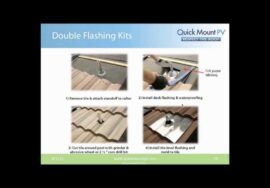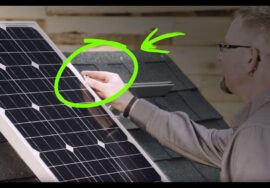5 Most Common Mistakes in Shingle Roofing
This video details the five most common mistakes when installing asphalt shingles. If you're attempting to replace or repair your roof, make sure you don't make these mistakes! Go now to to get the entire multi-part video series with all the information you'll need to install a shingle roof yourself. This video series is available to stream immediately online or to purchase as a DVD.
The most common mistakes include: putting the nails in the wrong place, using shingles on a flat or low slope roof, poor pipe flashing, using the incorrect overhang, and racking architectural shingles.
Chris is a professional roofer from Athens, Georgia and has created RoofingIntelligence.com to help homeowners and other roofers install their roofs easily and correctly.












Glad this video popped up on my YouTube recommended list… now I TOO am a roofing EXPERT!!! 😀
For a low slope patio cover, (.5″ per foot) what is the best method for adhering fiber reinforce rolled roofing to the drip edge. The mastic I used previously let loose after a number of years, causing rain water to wick back and then under the drip edge.
I think you accidentally illustrated one of the most common errors of roofing when you demonstrated using drip edge over the felt you wrapped around the roof edge; you held it up against the facia board, when in fact it’s very important to leave a decent gap between the drip edge and facia board to keep the water draining straight down (most recommend 1/2″ to 1″). A 1 x 2 furring strip works well. This Old House has a great short video showing why and how.
Thanks for the video! I’m re-roofing a dog house & have never done roofing before. What is the purpose of neoprene washers on *some* roofing nails, & are they useful – or a bad idea – when putting asphalt shingles onto plywood decking?
Also, I plan on putting a dab of silicone all-weather sealant over each galvanized, ribbed nail as I nail them in. Is that a good idea? Overkill?
Thank you in advance for your answers.
way overkill. it’s a doghouse. apply the shingles properly and there’s no need for anything extra. it ain’t rocket-science.
WWZenaDo just curious but how did it go?
I learned a lot from this video. Many thanks!!
Helpful Video – I think some aspects of roofing should be common sense. straight rows flat nails (not under/over driven), reading the instructions on the shingles for nail placement and overlap…
I would not watch this video and then attempt to lay a roof. But there are many in depth videos on that topic and this is not intended for that.
Thanks for publishing this video
Great video! You will be putting us ou of a job! : )
You’re a giant!
MastercapeRS lmao stop it ?
Good evening sir
Thank you for demonstration & it will help me a lot you are doing job,keep up your demonstration tutorial thank you,
Thirty years of installing and i think you should revamp at least number 4. With proper starter installed shingles can cantilever to an inch past the drop edge because it’s the same as D or A style. The application is the same to prevent capillary action. Manufactures generally say 3/8″ minimum. Also your drop edge demonstration though making a point you show improper application even though you just showed drop edge. Just as 3/8 to 1 inch is variable you should express there are a few ways to apply. There are different Pipeflashing also. Over all thanks improper application has ruined our industry and made me pretty well off!!
When I was a roofer, I told fellow roofers to put flashing in the valleys per the old way. To a man they told me they only would use the new way, which was simply to lace them up the valley without flashing. “My roofs never leak when I do it that way,” they would tell me. Five years later, driving through the same neighborhoods we roofed, I saw that nearly every valley had to be replaced after a few years.
thank you for this video. Very insightful.. Ill check out your others…
I’ve been a roofing Contractor for over 20 years and those are more like the least common mistakes I’ve seen
@Jimmy Sapien At least you’re dressed.
J. B.J. My mommy dresses me ?
Why in the he’ll would you use a rubber gasket pipe flashing in the first place?
Scott Weymer i agree !! like wtf are talking about
Being a contractor and being an inspector are very different things, It was not until I started doing consulting and getting my eyes on HUNDREDS of roofs that I realized the mistakes he mentions in this video and others, are very common. Perspective makes the difference
My roofing was 3 1/2 + 12 on shingle, two ply felt. Never leakie
hello question about a 2nd roof, I have a 200sq ft area around my A/C package unit on my roof the rest is tile, I am wanting to do a 2nd layer of composition shingles on top of my old ones around my A/C unit, should I use underlayment?? I know in my area you can have 2 layers and be in code. thanks for your help
Never double layer
Would have liked to have seen #5 demonstrated.
Thank you for your video question please can you install an overlay, composition over a wet roof..
No need to be dry
Would you recommend applying waterproof coating on the underlying plywood? Under the ice and water sheet? Also, how about top coating the asphalt shingles? Many thanks for the video.
This is a good video showing some basic mistakes. I like it!
Poor nailing patterns are the most common mistake that I see, causing blown off shingles. But the most damaging mistake that I see is improper drip edge install. The drip edge should never be tight to the frieze board but should have about a 3/16″ distance between the frieze and drip edge, if not then the water can wick against the frieze and fascia as well inevitably causing rot. This is guaranteed to happen. Another by-product of this is ‘staining’ of the frieze and fascia from the run off of the shingles. And when you start removing frieze and fascia you will discover that the roofers nailed into the frieze and fascia as well as adhering ice and water shield to the tops of them making removal that much more difficult.